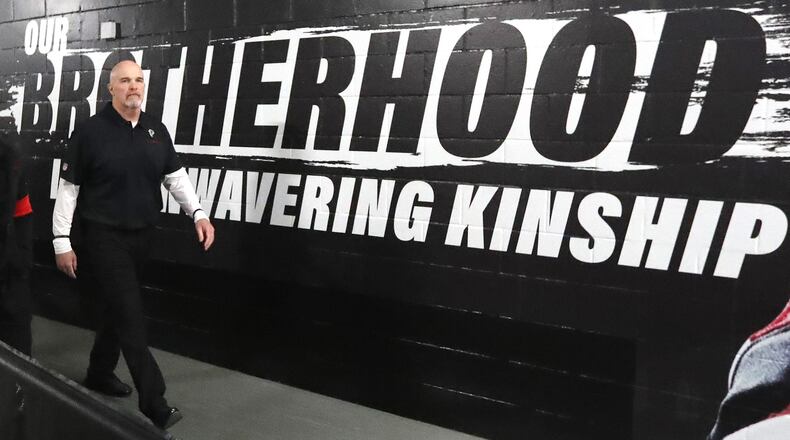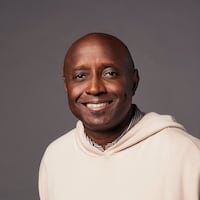The Falcons mostly stuck to the status quo after finishing 7-9 in 2019 so they’ll need more from their holdovers to be better next season (whenever it starts). They kept their coaching staff largely intact on the theory that the good returns from the midseason shakeup of 2019 will continue. After losing more player talent than they gained in free agency the Falcons need better production from recent draft picks and veterans (and contributions from incoming rookies).
The Falcons must get the small stuff right for their big picture plan to work. Team activities haven't been an option since late March with facilities closed because of the novel coronavirus pandemic. The Falcons said they'll open their building Tuesday for a limited number of employees, not including players and coaches . For now, Falcons coaches are issuing customized, virtual plans for individual players.
High school coaches, most of them from the state, recently participated in a virtual coaches’ clinic hosted by the Falcons. It was a chance for them to get tips from Falcons coaches as well as the state’s FBS college coaches. It was a chance for me to get a peek at how the Falcons are shaping their plans for player development.
Falcons defensive line/tackles coach Jess Simpson hosted one of the seminars. (It's a natural fit for Simpson, who was a legendary coach at Buford High.) In that session Simpson outlined one of the weekly, virtual plans he developed for Falcons defensive tackle Grady Jarrett.
Jarrett is one of the best defensive tackles in the NFL. He was selected to his first Pro Bowl in 2019. Jarrett had 9 ½ sacks last season, tied for third-most among defenders who usually line up inside.
“In my opinion, Grady is one of the top two or three edge rushing (tackles) in the NFL,” Simpson said during the seminar. “He’s got speed in his feet. He scares guards to death.”
Credit: Curtis Compton
Credit: Curtis Compton
But Simpson believes that Jarrett has yet to fully unlock one element of his pass rush. He showed the high school coaches one of the weekly “point of attack” plans he sent to Jarrett: “What’s the one thing that is going to make a player better and showing him how they can attain that.”
Simpson told the coaches that Jarrett recorded 50 quarterback pressures in 2019 (sacks, hits and hurries). He displayed a pie chart with 49 of those pressures categorized by type: 18 came on counter moves, 11 with effort plays, nine on “stunts” involving teammates, seven on edge rushes and four with power moves.
When Simpson sent Jarrett his improvement plan that week, he told (and showed) Jarrett how he can better take advantage of opponents who are too focused on countering his speed.
“So, we are going to build a tape to show him how can we do this and where are (opportunities) in your rush game that you really probably want to go speed to power right here,” Simpson said.
Simpson shows clips of plays from 2019 in which Jarrett successfully used a counter move. Jarrett takes a couple of quick steps to the outside of Eagles left guard Isaac Seumalo before whacking him with his left hand, beating him inside and hitting quarterback Carson Wentz soon after he throws the ball. Seahawks left guard Mike Iupati gets similar treatment from Jarrett, who sacks quarterback Russell Wilson.
Then Simpson showed video clips of three plays in which Jarrett didn’t take advantage of guards tipping their hands. On those plays Zach Fulton (Texans), Larry Warford (Saints) and Alex Cappa (Bucs) each stood tall at the snap and immediately turned their shoulders to set up for Jarrett’s speed rush. Jarrett essentially took himself out of those plays by continuing to rush upfield and going too wide to affect the quarterbacks.
Then came the final part of Simpson’s “point of attack” plan for Jarrett that week. He showed a clip of Jarrett using his power rush to stop a two-point conversion try by the Jaguars.
Left guard Andrew Norwell stands tall at the snap and turns his shoulders. Jarrett launches into Norwell’s chest and pushes him backwards. Jags quarterback Gardner Minshew II is forced to run away from Jarrett, who also induces a holding penalty against Norwell.
“For me to Grady, here is the evidence in the game, this is a big part of what Grady can do,” Simpson told the coaches. “There are going to be a ton of (opportunities) because he’s such a fast guy, he’s got great ‘get-off’ (quickness at the snap). ... Here are some (opportunities) for Grady to turn those edge rushers into power and let’s go from 50 pressures in (2019) to 60.”
All Falcons players have virtual plans like the one Simpson provided for Jarrett. It seems like a sound idea, under the circumstances. But working on their games outside of the virtual realm is tricky for players.
Most players are doing on-field work without teammates. They are scattered around the country and unable to gather in Flowery Branch. New Falcons players haven’t had any on-field work with their team, which is especially disadvantageous to rookies.
“The physical part, there has to be some self-starter part of that for sure because you’re not with a group of 90 putting it out,” Falcons coach Dan Quinn said. “You have to have a little self-talk. ‘I have to push it today.’ ”
Quinn is a relentlessly positive person. Soon after the novel coronavirus pandemic disrupted everything he declared that the Falcons will aim to do their virtual offseason better than their rivals. But Quinn admits that he had some doubts.
“I have to be honest, when we first talked about a virtual program I was definitely hesitant at first. ‘How the hell am I going to do this?’ ” Quinn said. “I found that there can be some great additions to what we’re doing. One of those is to customize programs for a player.”
The Falcons have a virtual “point of attack” plan for player development. They’ll need it to pay off once they finally put on the pads.
About the Author
The Latest
Featured



